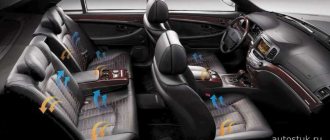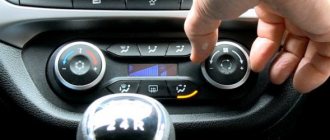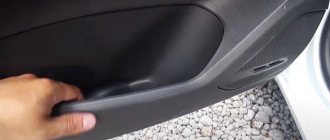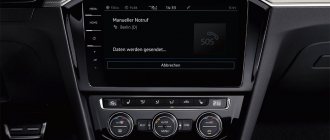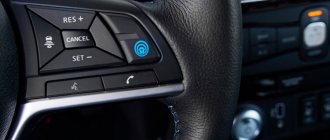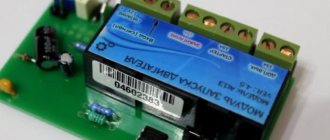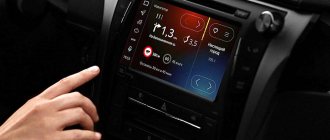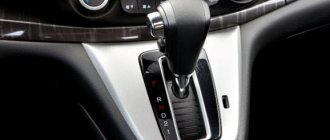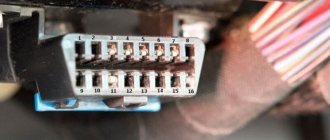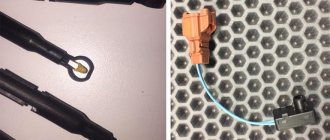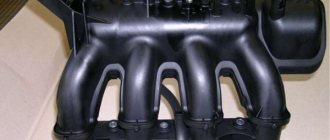Climate control system in the car provides comfort and convenience for the driver and passengers. Its main difference from an air conditioner is that it constantly maintains the specified climatic conditions. The system can be single- or multi-zone. Due to its complexity during operation, car owners may have a number of questions, in particular: “How to use the climate control? What to do, if Climate control does not turn on? How to conduct climate control cleaning? We will try to talk about this and much more in detail.
What is climate control in a car?
Automotive climate control (hereinafter referred to as CC) is a system consisting of an air conditioner, a heater, temperature and humidity sensors, a filtration system and an electronic control unit. The purpose of the system is to maintain the microclimate inside the car, regardless of the weather outside.
The operating principle of climate control is simple. It is based on the operation of an electronic feedback processor, which receives information from numerous sensors that record the temperature in different parts of the car interior. The user sets the desired temperature parameters in the control unit. And the processor supports them all the time, based on information from the sensors, and, if necessary, adjusting the operation of the cooling or heating systems.
The climate control device is fundamentally similar to stationary split-systems with feedback used in various rooms.
Interestingly, the climate control includes not only an air conditioner, but also a heater. Therefore, the system can also be used in winter to heat the interior. In addition, the air conditioner and heater dry the air passing through them. This makes it possible to prevent car windows from fogging up . In more advanced systems, the processor also takes into account the effect of sunlight on the interior temperature (the so-called ultraviolet sensor).
Sometimes there are even more sophisticated options. For example, some Infiniti models have an air ionizer.
Another feature of car climate control is the ability to recirculate air in the car if the outside air is too polluted. This is ensured by monitoring the filtration system. If the degree of air pollution exceeds the permissible norm, then the climate control does not take air from outside, but repeatedly rotates the air volume located in the car’s cabin. As a rule, this happens automatically.
Control
Design and operation of the pneumatic braking system
Maintaining the required interior microclimate is possible using the following components:
- Control block. Electronics are used to process incoming information from sensors. A special program automatically decrypts incoming data, after which instructions are formulated and transmitted to the driving devices;
- driving devices: various electric motors, dampers;
- entrance sensors.
Sensors
- Photodiode. Detects the ambient light level.
- Entrance sensor (external). Determines the outside air temperature and compares it with the cabin temperature. Located on the front of the car, behind the bumper.
- Exit sensors. The cabin air temperature is identified.
- Evaporator temperature sensors.
- Sensor that detects pressure (air conditioning).
- Drive device sensors.
- Sun sensor. Attached to the windshield, based on determining the influence of sunlight, it increases/decreases the temperature in the cabin.
- Sensor for determining the position of the sun relative to the car. You can find this function in a premium car. Comes complete with multi-zone installations. The essence of the device is to determine the temperature difference in the cabin and restore its balance.
Each sensor works as follows: analog signals are converted into digital ones and sent to the climate control unit.
Driver (actuator) elements of the air conditioning system:
- mechanical/electric drives;
- fan motor.
The elements are activated through a single control unit, which supplies the corresponding signals.
Air mass deflectors
Dampers control air flow and allow you to use climate control more efficiently. Kinds:
- central. Mixes streams of hot/cold air masses;
- recyclable. Allows you to close/open the flow of air into the cabin from the street. It is not recommended to frequently use the recirculation mode to avoid the formation of condensation on the evaporator, since the air inside the cabin has a higher humidity relative to the outside air;
- window ventilation;
- for supply air;
- separate dampers. For rear row passengers and multi-zone installations.
Which is preferable?
Air conditioning or climate control – which is better? In essence, “climate” is an air conditioner, only more functional. The answer to the question suggests itself, but not everything is so simple.
Advantages of "climate":
- possibility of setting a fixed air temperature. The air conditioner can only reduce/increase the fan speed, in other words, simply freeze. While his opponent allows both cooling the flow of air masses and heating;
- presence of automatic mode. The air conditioner is deprived of this function, which is why you have to constantly be distracted by adjusting it;
- the ability to save fuel consumption by turning off equipment when it reaches the desired temperature. The air conditioner works until you turn it off manually;
- “climate” is better tolerated by the human body due to a milder temperature transition. This is possible thanks to sensors in the cabin that send impulses to the control unit, which, in turn, sets a gentle temperature regime. Therefore, there is less risk of catching a cold. The air conditioner emits cold air sharply, creating a resonance between the outside temperature and the cabin temperature - which is fraught.
Climate control and its close relative are serviced in the same way - systems are checked and freon is replaced twice a year.
Types of climate control and their features
Climate control systems are divided according to different criteria - the presence of separate work zones, power, ease of control, and the presence of additional functions. First, let's talk about single- and multi-zone systems.
Operation of a multi-zone QC system
Today, single-zone, dual-zone, three-zone and four-zone climate controls . What is it and how are they different? Single-zone climate control is the simplest of the systems presented. It is designed according to the principle described above and controls the air parameters in the driver and front passenger area. Dual-zone climate control divides the air space between the driver and front passenger, respectively, into two parts, for which different climate parameters can be set. This provides additional convenience. Three- and four-zone systems also allow you to set individual climate parameters for rear passengers. The last option is considered the most advanced and comfortable.
Now a few words about the differences between climate control systems and the car air conditioning that is familiar today. Let's start with the last one. It performs two functions - it cools the air and dehumidifies it. That is, this device has no feedback. The driver must independently regulate the temperature supplied by the air conditioner in real time. And this is not always convenient. The main difference between climate control is precisely the presence of feedback, which is needed to maintain user-specified parameters on an ongoing basis.
The simplest single-zone climate control can operate in the following modes of automatic supply of cooled or heated air:
- legs;
- head;
- head/legs;
- windshield/legs;
- windshield (in this case, as a rule, the air is additionally dried to prevent fogging).
Multi-zone climate control systems have additional, more advanced operating modes for distributing air in the cabin.
Deviations from AUTO mode
In most cases, the default settings in automatic mode are optimal for the driver and all passengers in the vehicle, regardless of the time of year. But in some cases, it may be necessary to adjust the standard values of the climate system operating modes, which is what the device control keys are designed for. When making such changes, you should remember that they will continue to apply, that is, every time you turn on the Climatronic, it starts working in AUTO mode with new user settings.
Pressing buttons 11/12 allows you to adjust the fan rotation speed, that is, the power of the air flow penetrating into the cabin. You can visually track the current fan speed on the display using icon 2.
Pressing key 1 allows you to achieve the following results:
- disable recirculation and ECON modes;
- keep the windshield and all four side windows dry, preventing them from fogging up;
- increase the efficiency of removing ice and fogging from the front window (if, for example, new passengers with wet or damp clothes get into the car).
Button 10 is responsible for turning on the recirculation mode, which will be displayed on the display by the icon 5 lighting up. To turn off the recirculation mode, just press button 1. This mode will be useful if the car is moving along a dusty dirt road, or if there are unpleasant odors outside in a certain area of traffic (smoke, burning smell). In addition, using the recirculation mode will help cool (heat) the air faster and more efficiently, since in this mode it circulates in a closed circuit, heating up or cooling down faster.
The use of the recirculation mode imposes certain restrictions on the driver and passengers - in particular, smoking in this case is highly discouraged, since the tobacco smell will settle in the Climatronic evaporator and will penetrate into the cabin for quite a long time. It will be extremely difficult to get rid of it - in many cases it is easier to install a new evaporator. Buttons 13/14 allow you to change the direction of the airflow. It is possible to use buttons 1/13/14 simultaneously and in different combinations.
Button 17 is responsible for turning off the air conditioner. When operating in this mode, climate control only heats the air, without cooling it. This allows you to quickly reach the set temperature and, if possible, maintain it without using the air conditioner, that is, saving fuel. Button 1 deactivates ECON mode. Note that when operating in economy mode, the temperature inside the vehicle will be equal to or higher than the outside temperature.
You can change the temperature inside the cabin using buttons 15/16. It is possible to turn on the recirculation and economical modes at the same time - to do this, you first need to press button 10, and then press button 17 to turn on the ECON mode. You can forcefully turn off the climate control using key 11, which must be pressed and held until the word OFF appears on the display in the right corner (where FUTO lights up). The manufacturer recommends turning off Climatronic in exceptional cases (if, for example, system malfunctions are detected).
Note that the climate control control of the Volkswagen Polo (as well as other models with Climatronic) has the following feature: any changes to the operating mode of the climate system can be canceled by pressing button 9. But if you changed anything and then turned off the ignition, return to The previous parameters will no longer be possible - they will have to be set manually, and in order for them to be remembered, do not change them until the car is stopped and the ignition is turned off. Many car owners forget about this feature at first.
Climate control system design
Climate control consists of a large number of devices. In particular:
- Electronic control unit . This is perhaps the most important part of the system, its “brain”. It includes a controller with control programs and an information input system. These can be mechanical or electronic regulators. As a rule, information is entered into modern control units digitally, including using a remote control. Based on the incoming information, the controller program controls the executable devices - the fan rotation speed, the position of the dampers, and issues a command to increase or decrease the temperature of the blown air.
- Sensors _ They are located both inside the car and on the outside. Internal sensors monitor climate indicators in the areas where they are installed. There is also a separate temperature control sensor at the heater/cooler outlet. Interior sensors usually have forced airflow so that they provide information as quickly as possible. The more complex the system (multi-zone), the greater their number. External sensors are designed to monitor the temperature and air pollution outside the vehicle.
- Actuators . There are many devices that fall into this category. In particular, cooling and heating devices (air conditioner and stove), air dampers and their drive motors, air ducts, fans, filters, deflectors, and so on.
Components of the climate control system
It is not at all necessary for the driver to thoroughly know the internal workings of climate control. It is much more important to know the symbols on the climate control control knobs and how to configure the parameters. And also understand what preventive measures to take in order to keep the system in working order.
Components
It has already become clear that the basis of everything is an electrically adjustable control unit. With its help, the activity of all components is monitored, with the help of which climatic conditions are established for people inside the car. The work of such components is fine-tuned to the smallest detail, each is responsible for its purpose, and together they represent one organism. Each ECU contains:
- dampers;
- evaporative heating unit;
- capacitor;
- the contour part through which the refrigerant moves;
- heat exchanger;
- fan device;
- pipeline located under the casing.
How to use climate control
Different vehicles may use different controls to operate the climate control. But as a rule, the designations on them are standardized. Below we provide up-to-date information.
Review of dual-zone CC control on a Ford Focus 3
How to turn on climate control? Typically, a button with the words ON/OFF or an image of a broken circle is used for this. To turn on the air conditioner, use the button labeled A/C. The temperature in the general or separately in each zone is set using buttons or a rotary controller (roller). As a rule, the adjustment step is 0.5°C. The maximum difference between individual zones is 4...5°C. The AUTO button allows you to directly activate the system so that it automatically maintains the set temperature.
Also, in any climate control unit there are several buttons that indicate the direction of air movement. The minimum number is three. This is blowing the legs, blowing the head and legs, and blowing the windshield. Often there are more modes.
The CC control algorithm is basically the same for everyone; it all comes down to setting the required temperature with a knob or buttons and setting the blowing area. But still, different cars may have their own nuances, so it is better to find how to use climate control in the manual for your car or directly in the climate control operating instructions.
The air conditioning and climate control systems operate most efficiently at high engine speeds. Therefore, after turning them on, it makes sense to switch to a lower gear, while increasing the speed. When the temperature becomes comfortable, you can drive in optimal mode.
It is recommended to check the refrigerant system for leaks at least once a year. If necessary, refrigerant is added to the system. This needs to be done in a special service. It is also advisable to do diagnostics of the electronic unit there.
An example of button designations on the climate control control panel in Volkswagen cars
One more tip. The climate control system (like the air conditioner) must be turned on no earlier than one minute after starting the engine . And at the end of the trip it’s the other way around. Turn off the air conditioner at least one minute before stopping the engine.
The difference between the air temperature outside the car and inside the car should not exceed 10°C. Otherwise there is a risk to your health.
Where does the heat come from?
To better understand how climate control works in a car, you need to understand how all its components work individually. Let's start with the interior heater.
Heat is a byproduct of the engine running. In the summer (with the stove turned off), all the heat is released into the atmosphere. When the heater is turned on, part of this heat is used to heat the interior. When the heater is turned on, the tap opens, which is located in the line between the engine cooling jacket and the heater radiator. As the coolant passes through the radiator, it heats it up. Next, you need to distribute this heat throughout the cabin. The fan is responsible for this. Passing through the radiator honeycombs, cold air heats up and spreads through the air ducts throughout the cabin. The degree of heating of the flow can be adjusted by changing the amount of liquid that passes through the heater, and the intensity of the blowing changes by changing the rotation speed of the electric motor. These parameters are changed on the stove control panel. For convenience, there is also control over the direction of the airflow (on the legs, in the face, on the glass). The driver himself sets the priority direction of airflow. For example, in winter, when the car windows are covered with condensation, for a comfortable and safe ride, the priority will be to warm up the windshield and then turn on the airflow for the feet. The driver has to make all shifts on the go, which has a negative impact on road safety.
Installation of climate control
Some car owners whose cars are not equipped with a climate control system decide to install it additionally. This task requires spending a lot of time, money and effort. In addition, you need to know that the QC system may not be installed on every machine. After all, the fact is that the stove must be of a certain design so that it is possible to install various servos and wiring under the “dashboard”.
But if you still decide to install an additional climate control system on your own or with the help of specialists, then you will need the following list of devices and assemblies (may differ for different cars):
- electrical wiring from a similar car that has a climate control system (this is a whole wiring harness);
- a stove that was installed on a similar machine with a CC system, and working servos must be attached to it;
- two temperature sensors installed in the stove pipe;
- two temperature sensors installed in the central air ducts;
- solar radiation sensor (may not be part of the CC system);
- fan sensor with a cover-mount (the cover is usually very difficult to find); frame;
- control unit (the only element that is widely available).
Often, when installing a system, it is necessary to change the factory “torpedo” of the car. For this, different methods and materials are used. For example, fiberglass, from which additional elements are made for attaching CC controls. Work must be performed carefully so as not to damage factory elements.
The stove doesn't heat well
Car owners begin to notice that the stove is not heating well only with the arrival of cold weather, although the reasons for poor performance arise much earlier. Most often, the stove in a car heats poorly due to: airing, a faulty pump, a clogged radiator and cabin filter Read more
Car heater and care
A car heater is a heater radiator with the entire system as a whole. Periodic maintenance is required for proper functioning. The list of required work includes: checking, cleaning and replacing the cabin filter Read more
Diagnostics, repair and refilling of car air conditioning
A visual guide to car air conditioning maintenance and repair will help you properly maintain your car's air conditioner. Diagnostics are carried out not only when refilling freon, but also every seasonal maintenance.
How to install everything correctly?
Installation of climate control equipment is also a crucial moment.
The quality of the work performed depends on:
- Efficiency, correct operation of individual components and the system as a whole.
- Safety. The control unit, sensors, and other components operate from the electrical network, which, if installed incorrectly, can lead to dire consequences in the form of broken expensive equipment, electric shock, and even fire.
- Aesthetic properties of premises. If the controls and other structural elements look like foreign objects in the room, this means that the work was done poorly.
Initially, it is necessary to determine how to solve the problem of creating comfort.
A scenario in demand today is the creation of an optimal microclimate by controlling radiators, heated floors, and air conditioning. For remote control, just install the application on your gadget
In this case, the creation of a climate control system can be achieved in several ways:
- Connecting radiators, heated floors, air conditioning to one controller. This method of microclimate control is the simplest, most convenient and effective - the user only has to indicate his preferences and enjoy the benefits. But this option for creating a system is the most expensive, since many components are used.
- Connecting the listed heating devices to one controller, air conditioning to another. This option is more reliable than the one described above, because if one controller fails, the second will be able to perform its duties. At the same time, connecting an air conditioner can be an optimal solution only when the use of an external control unit makes it possible to expand its functionality.
- Connecting radiators and air conditioners to one controller, while the air conditioner is not connected to any control systems. This installation method is as reliable as the previous one, and is also the most affordable. It is considered optimal when the air conditioner is equipped with an effective internal control unit.
Moreover, the less expensive last method is often chosen; as a result, the user will only have to install heating equipment.
The basis of any system is the controller to which all structural elements are connected. The correct operation of all functions depends on the correctness of its choice.
Why you will need to purchase a set of equipment, including:
- controller;
- temperature sensors - one for each room;
- relay block;
- servo drives - one for each radiator, and for heated floors the same number for each room, circuit;
- electrical cabinet with a DIN rail, which can be DR-30-12.
In addition, you will need power wires and twisted pairs.
Then you can proceed to the installation itself, which involves performing the following steps:
- Installation of the electrical cabinet on which the controller and relay unit are located.
- Installation of servo drives. They are located on the coolant control combs or on each radiator.
- All servos are connected to a power cable, and they, in turn, are connected to the controller.
- A temperature sensor is installed in each room (in the center), then it is connected to the relay using a twisted pair. If wireless products are used, a data reception gateway will need to be installed.
After all of the above, testing and adjustment procedures are performed.
What to do when climate control does not work
Self-diagnosis of climate control on Nissan Tiida
The QC system, like any mechanism, can fail. Let's take a closer look at how to independently diagnose climate control . Let’s immediately make a reservation that different machines and systems may have their own specifics, and even more so the decoding of their errors. As an example, let's look at the QC self-diagnosis on a Nissan Tiida. The verification algorithm looks like this:
- Turn on the ignition and press the OFF button in order to set the CC system to self-diagnosis mode. At the same time, all the elements present there will appear on the screen, and the corresponding indicators will light up next to the buttons. The first diagnostic step is to check whether all of the listed elements are lit.
- The second diagnostic stage is to check for open circuits in the temperature sensors. To do this, use a roller to increase the temperature one step. The display shows the number “2”. At the same time, self-diagnosis of the circuits is performed to determine the presence of breaks in them. If after some time “20” is displayed instead of “2”, this means that no faults were detected. If instead there is another number, then this will be an error code, the decoding of which you can see in the manual.
- Checking the position of the damper mixers and the blower damper. You need to raise the temperature one more step. The number “3” will appear on the screen. After which a self-diagnosis will occur. If there are no faults, then the number “3” will turn into “30”. Otherwise, you should also look for an explanation of the error in additional literature.
- Check the motors of all dampers in the system. To do this, raise the temperature again by one degree. There are 6 different dampers on the machine. Switching between them is done by pressing the corresponding buttons with images of the blowing direction. At the same time, each of them turns on in turn, and the driver can tactilely check whether air is coming from the air ducts or not.
- Temperature check detected by sensors. The procedure is carried out on a cold machine to avoid large variations in readings. To do this, we again increase the temperature by one step. The number “5” lights up on the display. The first thing to check is the ambient temperature sensor. Press the windshield defogger button. You will see the outside temperature on the screen. The next time you press the button, you will see information from the cabin temperature sensor (in degrees Celsius). When you press the same button a third time, information about the intake air temperature (also in degrees Celsius) will appear on the display.
- Correction of temperature sensor readings. With its help, you can set the adjustment range for the temperature detected by the sensor in the range from -3°C to +3°C. To do this, you need to set the diagnostic mode to “5” again, and then use the fan speed control knob to increase them by one position. In this case, the display shows “0”, which corresponds to the fact that the sensor will show the temperature without adjustment. By rotating the knob to the right or left, you can set any value from -3°C to +3°C. This makes it possible to correct the actual temperature value compared to the one produced by the sensor.
Let us repeat that climate control diagnostics differ on different machines. You can find the exact algorithm and explanation of errors (if any) only in the manual of your car or the CC itself.
A little theory
An intelligent system that provides multi-zone creation of an ideal microclimate creates conditions for effective mixing of cold and hot air flows generated by the air conditioner and stove, respectively, in order to obtain the output temperature corresponding to the one specified in the settings. And since we are talking, first of all, about cooling, when the heat outside is over 25º C, the air conditioner becomes the main link in the climate system. The principle of its operation is based on the processes of transition of a substance from one state of aggregation to another. In modern refrigeration units, freon is used as a refrigerant, the physical characteristics of which allow it to pass from a gaseous to a liquid state and, vice versa, under conditions optimal for a closed circuit.
It is during these transitions that either heat is released, which is dissipated outside, or cold, which is pumped into the vehicle interior. Using an air conditioner turned out to be a good thing, allowing you to get rid of the unbearable heat in the cabin without opening the windows in a moving car - this method of cooling is fraught with troubles for the body.
However, the air conditioner also has certain disadvantages - if used inappropriately, it may well cause colds. In addition, its use requires constant adjustment of the temperature of the incoming air flow, since when driving with acceleration and braking it is impossible to obtain stable cooling indicators.
Malfunction prevention
In order for the climate control system in a car to work properly, it is necessary to periodically service its individual components. First of all, we are talking about the air conditioner radiator. Freon pressure should always be normal and should be monitored at least once a year.
Don't forget to periodically change the cabin ventilation filter . Especially if you frequently use the climate control system. Over time, it becomes clogged and the performance of the ventilation system decreases. And, of course, you have to breathe in the accumulated dust and germs. It is also necessary to clean the air conditioner radiator from dust accumulated on its surface. To do this, the system must be turned on periodically for ventilation, even in winter, at least once a month, for at least 5...10 minutes.
The third preventative measure is to clean the interior ventilation . There are several methods for this. For this purpose, special means are used - cleaners, aerosols, steam generators, “smoke bombs”. They effectively cleanse the system and destroy harmful microorganisms in it.
Recirculation mode
How does climate control work in a car?
The main purpose of this mode is to prevent bad-smelling or heavily polluted outside air from entering the cabin. The mode is activated by pressing button 13. The fact that the mode is turned on is indicated by a yellow light built into the button. Typically, this mode is turned on when the car is in a traffic jam (to prevent exhaust gases from entering the cabin) or when driving on a dirt road (to protect against dust from entering the cabin). The recirculation mode will be useful in cool weather, since in this case the cold outside air will not be used.
At very high outside temperatures and low vehicle speeds, the recirculation mode will also be useful, since in this case, instead of hot outside air, cooled cabin air will circulate. Note that when the recirculation mode operates for a long time, the air humidity increases, especially if there are several people in the car, which will lead to fogging of the windows.
Advantages and disadvantages of climate control
Like any technical system, climate control has its advantages and disadvantages. They are identified not only by specialists, but also by ordinary consumers. Let's start by listing the advantages:
- ensuring comfortable living conditions in the car for the driver and passengers (especially for multi-zone systems);
- automatic operating mode;
- a large number of adjustable parameters;
- minimizing human participation in the operation of the system;
- a simple, convenient and intuitive interface that ensures quick learning of working with the system.
Disadvantages of climate control include:
- increased price of a car equipped with such a system;
- high cost of maintenance and repair;
- increased fuel consumption when the system is used;
- Repairing the climate control system yourself is not possible.
However, despite the existing shortcomings, more and more modern cars are equipped with a climate control system as standard. Engineers find new solutions for its implementation, and mass production makes it possible to constantly reduce the price.
Conclusion
The climate control system allows the driver and passengers of the car to create a comfortable atmosphere in the cabin for long trips. Unlike a traditional air conditioner, it has feedback , allowing the output temperature to be adjusted in real time based on changing input data. And this, firstly, creates comfort for people, and secondly, minimizes their participation in managing the system. However, during operation, do not forget to clean and maintain the climate control. This will ensure its long and trouble-free operation. It is advisable to use climate control not only during long trips, but also when driving in city traffic jams.
Some modern cars that have an engine preheating function, as a rule, make it possible to turn on the climate control before the driver enters the cabin in order to create a comfortable temperature in advance.
If you decide to buy a new car, be sure to look for a model with climate control. You certainly won't regret it!
Operating principle of the air conditioning system
For a comfortable stay in a car in the summer, you need a system that will cool the air coming from the street. And if everything is more or less clear with the heater, then it’s harder to guess where the cold will come from for a hot engine. The best way to explain how a car's air conditioning works is to describe what happens to the refrigerant as it moves through the system. Let's start our description with the compressor. It is located under the hood of the car and is driven by the rotation of the engine crankshaft.
- A compressor is a simple pump that pumps refrigerant through the system. Hot freon under high pressure passes through a tube to the condenser.
- The condenser sits in front of a car's radiator and looks the same and does the same thing as a radiator: it uses the flow passing through it to cool the gas. The hot refrigerant condenses into a cold liquid as it cools.
- Liquid freon now flows through the high pressure pipe to the valve. Depending on the brand of car, this valve is called either a thermal or expansion valve.
- The valve allows only a small amount of freon to pass through and also reduces the pressure created by the compressor.
- Cold, low-pressure refrigerant enters the evaporator, which is similar to a stove radiator. But since freon is cold, the flow that passes through it is cooled.
- The same heater fan is responsible for circulating air through the evaporator.
Diagram of how an air conditioning system works
Once the cycle is complete, the refrigerant flows back into the compressor through the low pressure pipe, starting the cycle again. Adjusting the degree of cooling and airflow intensity is also the responsibility of the driver.
These systems are very important and useful; not only comfort, but also safety depends on their operation. And if previously cars were equipped with air conditioning only in expensive trim levels, now this option is already included in the database. Both systems (heating and air conditioning) are located in one unit. Switching flows (from the radiator to the evaporator) occurs due to the movement of the damper. Many have noticed that during a long trip it becomes either unbearably hot or cold (depending on what is turned on). In order to make the temperature in the cabin comfortable, you need to equip the car with an automatic regulator. Its difference from a simple air conditioner with a stove is that they have a common electronic control system with a set of sensors. The driver just needs to set the required parameters once, and the climate control itself will choose what needs to be turned on in the given weather conditions. The climate control system works by reading information from sensors and deciding what exactly needs to be turned on at the moment, and with what intensity. Once the temperature in the cabin reaches the set temperature, the climate control will switch to support mode. More advanced systems have additional sensors for determining outside temperature and sunlight sensors to respond to any changes. In more expensive versions of cars, climate control can be two, three or even four zones, so that everyone can set the necessary parameters for themselves.
